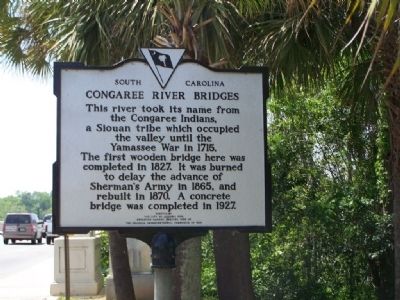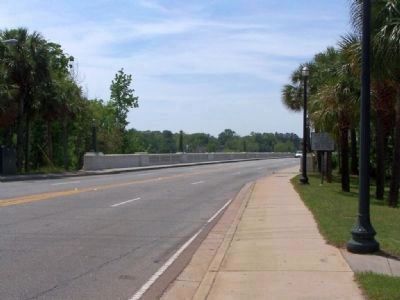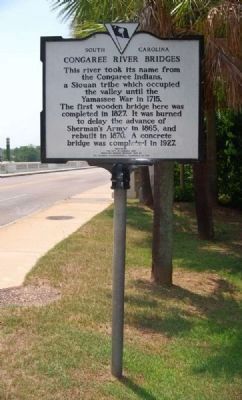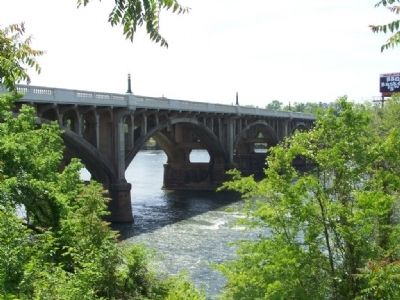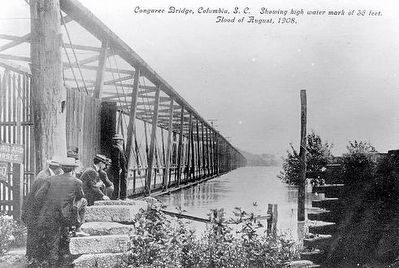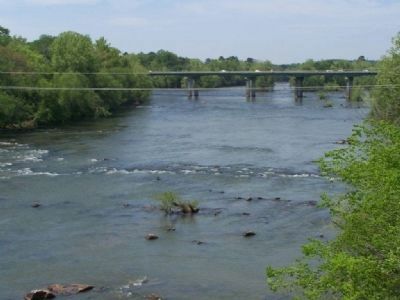Midtown - Downtown in Columbia in Richland County, South Carolina — The American South (South Atlantic)
Congaree River Bridges
This river took its name from the Congaree Indians, a Siouan tribe which occupied the valley until the Yamassee War in 1715. The first wooden bridge here was completed in 1827. It was burned to delay the advance of Sherman's Army in 1865, rebuilt in 1870. A concrete bridge was completed in 1927.
Erected 1966 by the City Of Columbia 1966, replacing marker erected in 1938 by the Columbia Sesquicentennial Commission of 1936. (Marker Number 40-38.)
Topics. This historical marker is listed in these topic lists: Bridges & Viaducts • Native Americans • War, US Civil • Waterways & Vessels. A significant historical year for this entry is 1715.
Location. 33° 59.783′ N, 81° 2.947′ W. Marker is in Columbia, South Carolina, in Richland County. It is in Midtown - Downtown. Marker is on Gervais Street (U.S. 1/378), on the right when traveling west. Located at the east end Gervais Street Bridge. Touch for map. Marker is in this post office area: Columbia SC 29201, United States of America. Touch for directions.
Other nearby markers. At least 10 other markers are within walking distance of this marker. Columbia Canal (within shouting distance of this marker); Gervais Street Bridge (within shouting distance of this marker); 1896 Power Plant (within shouting distance of this marker); Harnessing Water Power (about 300 feet away, measured in a direct line); Doolittle Raiders (about 600 feet away); Williams Street / Gist Street (about 700 feet away); Milestones (approx. 0.2 miles away); Friday’s Ferry (approx. ¼ mile away); Old Congaree River Bridges (approx. ¼ mile away); “City of Columbia” Anchor (approx. ¼ mile away). Touch for a list and map of all markers in Columbia.
Related markers. Click here for a list of markers that are related to this marker. Markers detailing the Congaree River Bridges
Also see . . .
1. Gervais Street Bridge. One of four open spandrel arch bridges of reinforced concrete in South Carolina, the Gervais Street Bridge spans the Congaree River and links Columbia to the western and southern parts of the state. (Submitted on August 15, 2009, by Brian Scott of Anderson, South Carolina.)
2. Congaree Indian Tribe History. Congaree. A small tribe, supposed to be Siouan, formerly living in South Carolina. (Submitted on August 15, 2009, by Brian Scott of Anderson, South Carolina.)
3. Yamasee War. The Yamasee War (also spelled Yemassee War) (1715-1717) was a conflict between colonial South Carolina
and various Native American Indian tribes including the Yamasee, Creek, Cherokee, Chickasaw, Catawba, Apalachee, Apalachicola, Yuchi, Savannah River Shawnee, Congaree, Waxhaws, Pee Dee, Cape Fear, Cheraw, and many others. (Submitted on August 15, 2009, by Brian Scott of Anderson, South Carolina.)
Additional commentary.
1. Gervais Street Bridge - National Register Nomination Form
Begun in February 1926 and completed in June 1928, the 1,415 foot reinforced concrete bridge was constructed by Hardaway Contracting Company of Columbus, Georgia. It cost $597,167 to construct. The bridge was designed by Joseph W. Barnwell of Charleston, SC, bridge engineer for the State highway Department.
The bridge has a closed spandrel concrete were founded in the rock in the Congaree River, located at the state's "fall line". Thirty-six feet wide, the bridge has four lanes and two cantilevered sidewalls each six feet wide. Above the flanking balustrades are cast iron light fixtures. decorative fixtures have the letter C and a palmetto on the bases, a vine pattern on the eight-side post, and an aecanthus leaf design on the necking.
No alterations have been made to the bridge except for removal and repaving of asphalt.
Significance
One of four open spandrel arch bridges of reinforced concrete in South Carolina, the Gervais Street bridge spans the Congaree River and links Columbia to the western and southern parts of the state. At the time of its construction, this bridge had the widest roadway in the state (two feet wider than the Ashley River bridge in Charleston, SC). From 1928 until 1953, the Gervais Street bridge was the only Columbia Congaree River bridge and is presently the earliest and most decorative of the three bridges across the river.
The site has historically served bridges and ferries. Ferry service was first burned in 1865 to delay Sherman's army. The rebuilt wooden bridge was privately owned until 1912 when it was purchased by Richland County in cooperation with Lexington County.
— Submitted August 15, 2009, by Brian Scott of Anderson, South Carolina.
Credits. This page was last revised on February 16, 2023. It was originally submitted on April 26, 2008, by Mike Stroud of Bluffton, South Carolina. This page has been viewed 2,111 times since then and 62 times this year. Photos: 1, 2. submitted on April 26, 2008, by Mike Stroud of Bluffton, South Carolina. 3. submitted on August 15, 2009, by Brian Scott of Anderson, South Carolina. 4. submitted on April 26, 2008, by Mike Stroud of Bluffton, South Carolina. 5. submitted on August 15, 2009, by Brian Scott of Anderson, South Carolina. 6. submitted on April 26, 2008, by Mike Stroud of Bluffton, South Carolina. • Craig Swain was the editor who published this page.
